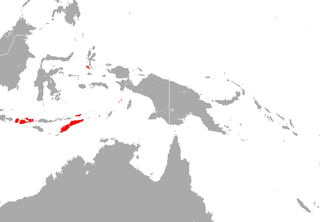Related Research Articles

The insular horseshoe bat is a species of bat in the family Rhinolophidae. It is endemic to Indonesia.

Spermacoce or false buttonweed is a genus of flowering plants in the family Rubiaceae. It comprises about 275 species found throughout the tropics and subtropics. Its highest diversity is found in the Americas, followed by Africa, Australia and Asia.

The Kei flying fox is a species of megabat in the genus Pteropus found in the Kai Islands of Indonesia. It was formerly considered a subspecies of the black-bearded flying fox. Very little is known about the species, its habitat, or threats to it.

Anthene seltuttus, the dark ciliate blue, is a butterfly of the family Lycaenidae. It is found in Australia, New Guinea, Indonesia and a number of bordering Pacific islands.

Tiliqua gigas is a close relative of the Eastern blue-tongued lizard. They are endemic to the island of New Guinea and other various surrounding islands. They are found typically in the rainforest, and in captivity, require high humidity. As opposed to Tiliqua scincoides, they are fairly lean. They're also accompanied by long tails. There are currently three subspecies of Tiliqua gigas. First subspecies to be recognized is Tiliqua gigas gigas, in which are simply called the Indonesian blue-tongued skink. The second subspecies is Tiliqua gigas keyensis, typically called the Kei island blue-tongued skink. Lastly, there is Tiliqua gigas evanescens, which is called the Merauke blue-tongued skink.
Spermacoce keyensis, the Florida false buttonweed, is a species of plants in the family Rubiaceae, first discovered in the Florida Keys. It is found in southern Florida, Bahamas, and the extreme southern tip of Texas.
Paranandra is a genus of beetles in the family Cerambycidae, containing the following species:

Abatocera is a genus of beetles in the family Cerambycidae, containing the following species:

Pterolophia is a genus of longhorn beetles of the subfamily Lamiinae, containing the following species:
Ropica keyensis is a species of beetle in the family Cerambycidae. It was described by Breuning in 1953.
Abatocera keyensis is a species of beetle in the family Cerambycidae. It was described by Breuning in 1943. It is known from Indonesia.
Pterolophia ingrata is a species of beetle in the family Cerambycidae. It was described by Francis Polkinghorne Pascoe in 1864.

Pterolophia melanura is a species of beetle in the family Cerambycidae. It was described by Francis Polkinghorne Pascoe in 1857. It has a wide distribution in Asia.
Pterolophia gibbosipennis is a species of beetle in the family Cerambycidae. It was described by Maurice Pic in 1926.
Pterolophia instabilis is a species of beetle in the family Cerambycidae. It was described by Per Olof Christopher Aurivillius in 1922. It is known from Seychelles.
Pterolophia angulata is a species of beetle in the family Cerambycidae. It was described by Hermann Julius Kolbe in 1893. It has a wide distribution in Africa. It feeds on Lagerstroemia indica.
Pterolophia guineensis is a species of beetle in the family Cerambycidae. It was described by James Thomson in 1864, originally under the genus Alyattes.
Oberea keyensis is a species of beetle in the family Cerambycidae. It was described by Stephan von Breuning in 1961.

Jacquinia keyensis, commonly called Joewood, is a woody plant in the primrose family. It is native to the West Indies, where it is widespread on many islands. Its natural habitat is coastal strand, often on coral exposures with salt spray.
References
- ↑ BioLib.cz - Pterolophia keyensis. Retrieved on 8 September 2014.